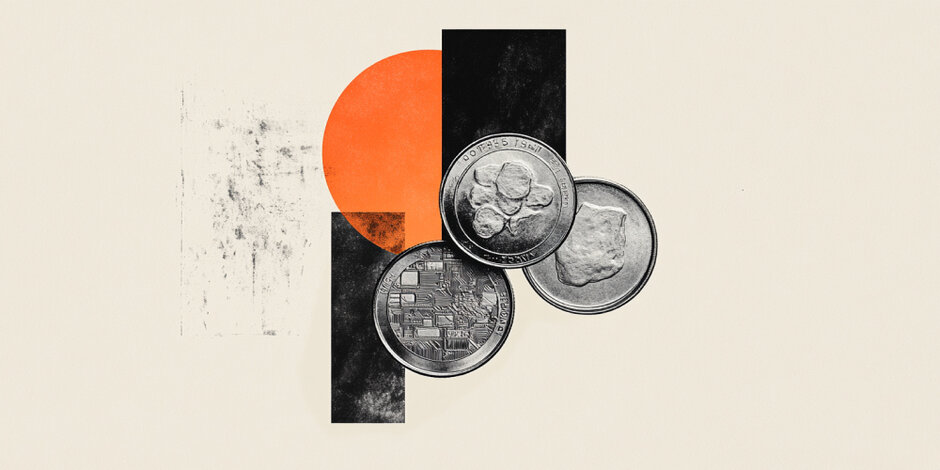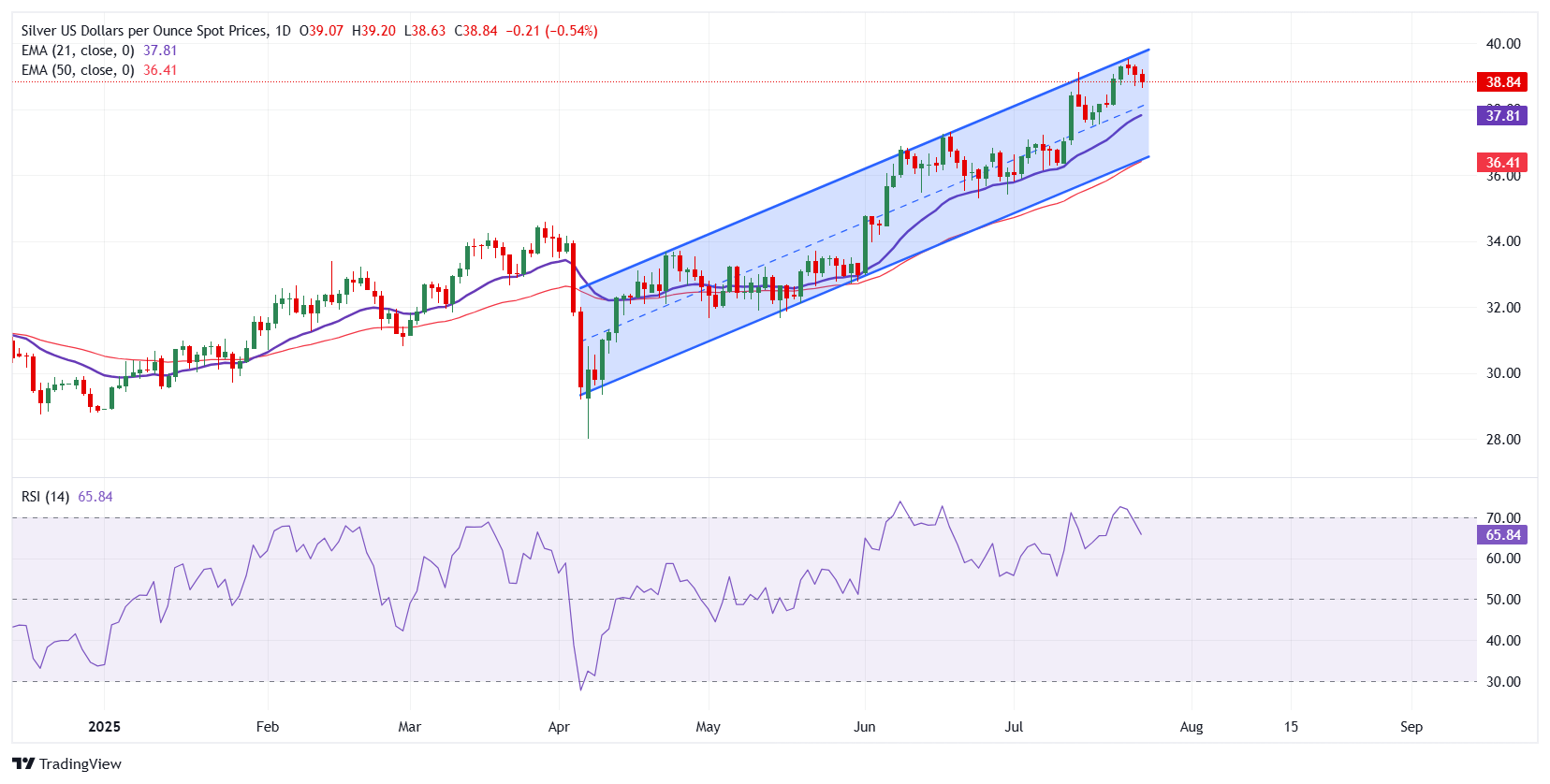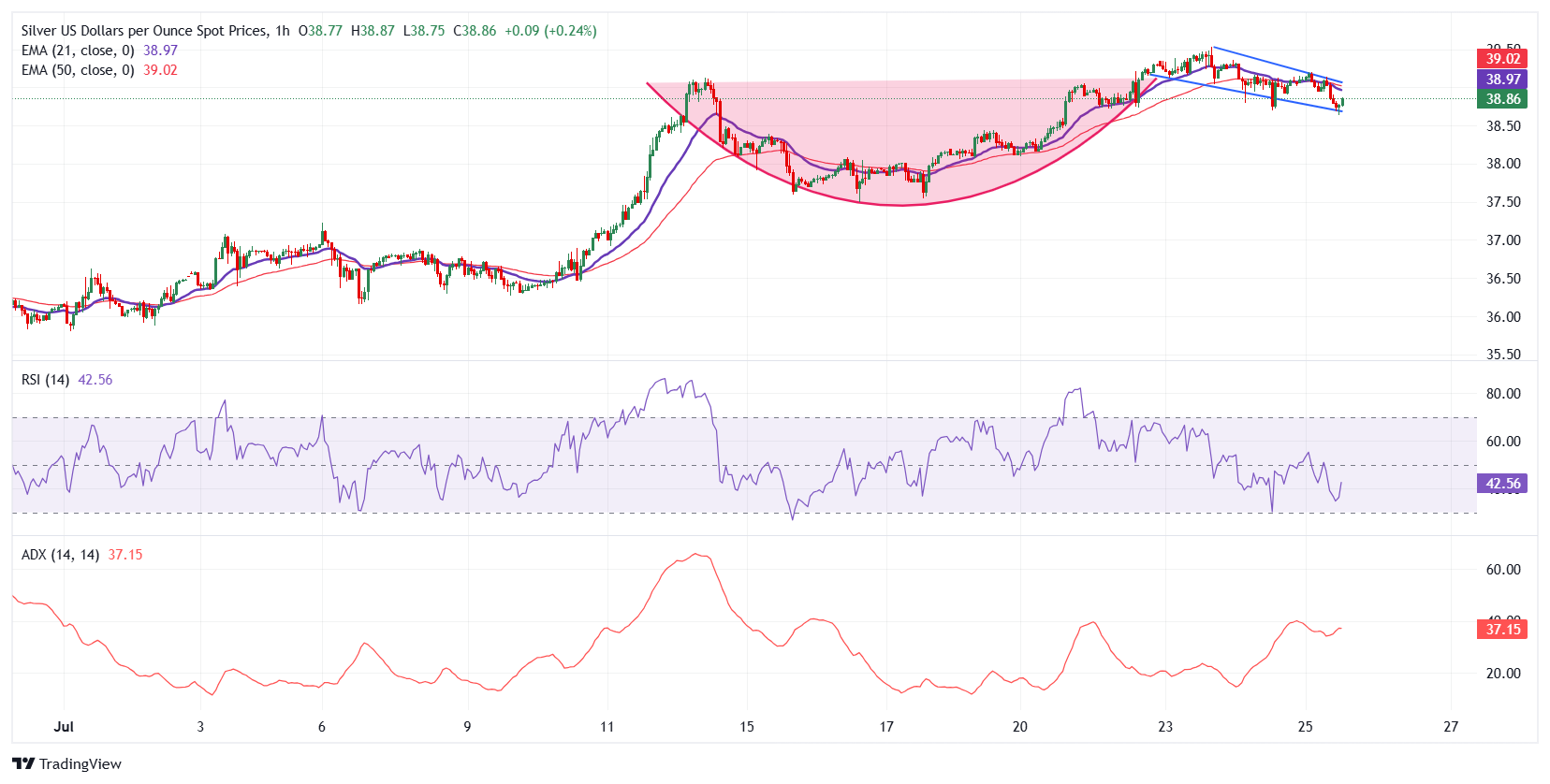Created
: 2025.07.25














![]() 2025.07.25 22:04
2025.07.25 22:04
Silver (XAG/USD) corrects lower for a third day on Friday, easing to around $38.84 after hitting a fresh 14-year high of $39.53 earlier in the week. The pullback reflects improved global risk sentiment and a modest rebound in the US Dollar (USD), as upbeat US macro data and signs of easing trade tensions dampen safe-haven demand. Despite the decline, the metal remains up nearly 1.70% so far this week, underscoring the strength of the broader bullish trend.

On the daily timeframe, Silver continues to trade within a well-established ascending channel that has contained price action since April. The metal remains comfortably above both the 21-day Exponential Moving Average (EMA) at $37.81 and the 50-day EMA at $36.41. Both EMAs are sloping upwards, indicating that the bulls are still in control.
The Relative Strength Index (RSI) on the daily chart has eased to 65 from overbought levels, reflecting a healthy cooldown rather than a trend reversal.
Immediate support lies at $38.70, the July 22 low, followed by the psychological $38.00 mark. A break below these levels could accelerate the downside toward the 21-day EMA at $37.81. Further weakness may bring stronger support near $36.41, where the 50-day EMA aligns with the lower boundary of the ascending channel. On the upside, $39.00 now serves as the first hurdle, followed by $39.53 high of July 23.
A decisive move above this zone could reignite bullish momentum and pave the way for a test of the psychological $40.00 handle, with potential extension toward $42.00 and beyond.

The hourly chart shows bearish pressure building, despite an earlier bullish setup. Silver recently carved out a classic cup-and-handle formation, with the handle forming as a falling wedge pattern -- usually a bullish sign. However, the breakout attempt above the $39.00 mark lacked follow-through, and the price has since fallen back below the 21-period EMA at $38.96 and the 50-period EMA at $39.00. Notably, the 21-period EMA has now crossed below the 50-period EMA, turning these levels into immediate resistance.
On the downside, if the price breaks below the lower boundary of the handle formation, it could trigger further weakness toward $38.50 in the near term. The Relative Strength Index (RSI) on the hourly chart has also retreated to near 41, reflecting fading intraday momentum and a possible consolidation phase. Meanwhile, the Average Directional Index (ADX) remains elevated at around 37, indicating a still-active trend, although the loss of upward follow-through signals is growing caution among bulls.
Silver is a precious metal highly traded among investors. It has been historically used as a store of value and a medium of exchange. Although less popular than Gold, traders may turn to Silver to diversify their investment portfolio, for its intrinsic value or as a potential hedge during high-inflation periods. Investors can buy physical Silver, in coins or in bars, or trade it through vehicles such as Exchange Traded Funds, which track its price on international markets.
Silver prices can move due to a wide range of factors. Geopolitical instability or fears of a deep recession can make Silver price escalate due to its safe-haven status, although to a lesser extent than Gold's. As a yieldless asset, Silver tends to rise with lower interest rates. Its moves also depend on how the US Dollar (USD) behaves as the asset is priced in dollars (XAG/USD). A strong Dollar tends to keep the price of Silver at bay, whereas a weaker Dollar is likely to propel prices up. Other factors such as investment demand, mining supply - Silver is much more abundant than Gold - and recycling rates can also affect prices.
Silver is widely used in industry, particularly in sectors such as electronics or solar energy, as it has one of the highest electric conductivity of all metals - more than Copper and Gold. A surge in demand can increase prices, while a decline tends to lower them. Dynamics in the US, Chinese and Indian economies can also contribute to price swings: for the US and particularly China, their big industrial sectors use Silver in various processes; in India, consumers' demand for the precious metal for jewellery also plays a key role in setting prices.
Silver prices tend to follow Gold's moves. When Gold prices rise, Silver typically follows suit, as their status as safe-haven assets is similar. The Gold/Silver ratio, which shows the number of ounces of Silver needed to equal the value of one ounce of Gold, may help to determine the relative valuation between both metals. Some investors may consider a high ratio as an indicator that Silver is undervalued, or Gold is overvalued. On the contrary, a low ratio might suggest that Gold is undervalued relative to Silver.
![]()
Created
: 2025.07.25
![]()
Last updated
: 2025.07.25

FXStreet is a forex information website, delivering market analysis and news articles 24/7.
It features a number of articles contributed by well-known analysts, in addition to the ones by its editorial team.
Founded in 2000 by Francesc Riverola, a Spanish economist, it has grown to become a world-renowned information website.
We hope you find this article useful. Any comments or suggestions will be greatly appreciated.
We are also looking for writers with extensive experience in forex and crypto to join us.
please contact us at [email protected].
Disclaimer:
All information and content provided on this website is provided for informational purposes only and is not intended to solicit any investment. Although all efforts are made in order to ensure that the information is correct, no guarantee is provided for the accuracy of any content on this website. Any decision made shall be the responsibility of the investor and Myforex does not take any responsibility whatsoever regarding the use of any information provided herein.
The content provided on this website belongs to Myforex and, where stated, the relevant licensors. All rights are reserved by Myforex and the relevant licensors, and no content of this website, whether in full or in part, shall be copied or displayed elsewhere without the explicit written permission of the relevant copyright holder. If you wish to use any part of the content provided on this website, please ensure that you contact Myforex.
Myforex uses cookies to improve the convenience and functionality of this website. This website may include cookies not only by us but also by third parties (advertisers, log analysts, etc.) for the purpose of tracking the activities of users. Cookie policy